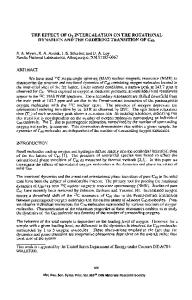The intercalation of Ar into C 60 films
- PDF / 114,725 Bytes
- 4 Pages / 612 x 792 pts (letter) Page_size
- 3 Downloads / 341 Views
MATERIALS RESEARCH
Welcome
Comments
Help
The intercalation of Ar into C60 films G. E. Gadd, P. J. Evans, S. Moricca, and M. James Australian Nuclear Science and Technology Organisation, Private Mail Bag 1, Menai, NSW 2234, Australia (Received 20 November 1995; accepted 27 September 1996)
In this Communication we discuss how unimplanted and implanted films (Y and Au implanted) of C60 , when hot isostatically pressed (HIPed) at a pressure of 170 MPa (1.7 kbar) of Ar and temperatures of 300 or 400 ±C, show substantial uptake of Ar into the film. Rutherford backscattering (RBS) provides an effective method for elucidating film composition, showing the films to have ,1.5 at. % of Ar, consistent with a stoichiometry close to Ar1 C60 . The Ar was found to diffuse from the films when these were held in a vacuum at 300 ±C. It could subsequently be reincorporated into the film by re-HIPing, with uptake of a similar amount of Ar. IR spectroscopy showed that the C60 IR absorptions remain unchanged throughout uptake of the Ar and its subsequent loss during heating at 300 ±C. It appears that the Ar is trapped interstitially in the films outside the C60 cages.
Interest in the interaction of various gases with fullerene compounds has grown in the past few years,1 stimulated in part by the increasing commercial availability of these materials. In particular, it has been shown that both O2 and H2 penetrate the lattice of C60 and C70 2 and occupy the octahedral sites. Recently,3 the room temperature compressibility of C60 and intercalation of He, Ne, and Ar into C60 has been studied as a function of pressure. It was concluded that He easily diffused into the face-centered cubic (fcc) lattice whereas Ar did not. The present paper describes experiments in which the incorporation of Ar into the C60 lattice was observed. The possibility of introducing metallic and other species into fullerene films by ion implantation has been the subject of several studies.4–6 In all cases, implantation caused decomposition of C60 in the implanted region, resulting in the formation of an amorphous carbon layer. While the primary aim of directly doping fullerenes by this method was not achieved, it was found that the amorphous carbon layer served to passivate the surface, providing increased stability upon exposure to air. In the present study, ion implantation was used to form a protective layer on C60 films prior to subjecting them to HIPing at elevated temperatures. This approach resulted in reduced degradation of C60 , particularly at temperatures .300 ±C, compared with similarly treated, unimplanted films. In addition, increased retention of Ar was observed for the implanted films under some conditions. Films of C60 on single crystal Si disks (25 mm diam. 3 1 mm thick) were prepared by sublimation of J. Mater. Res., Vol. 12, No. 1, Jan 1997
http://journals.cambridge.org
Downloaded: 16 Mar 2015
C60 (solid black fcc crystals of purity 99.91%) from a tungsten crucible at ,400 ±C. Atomic force microscopy (AFM) and transmission electron microsco
Data Loading...










